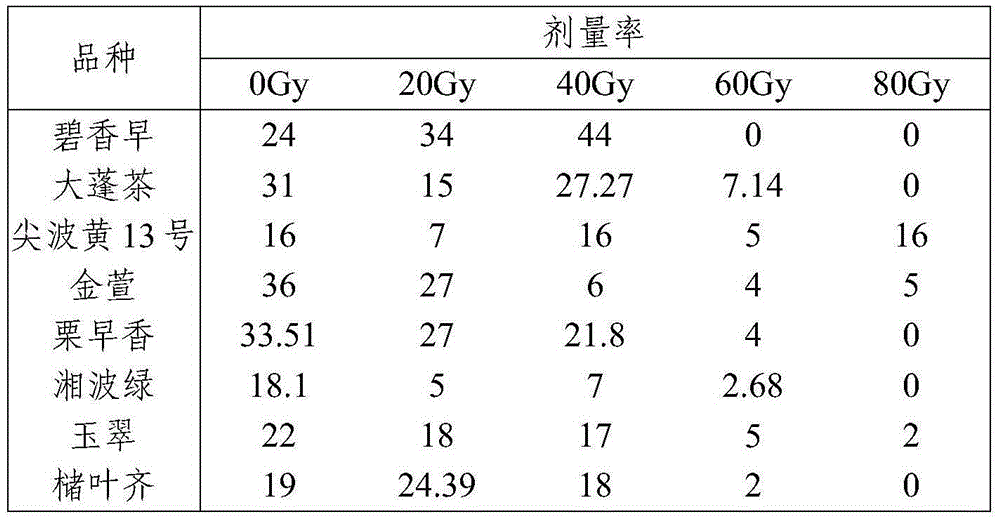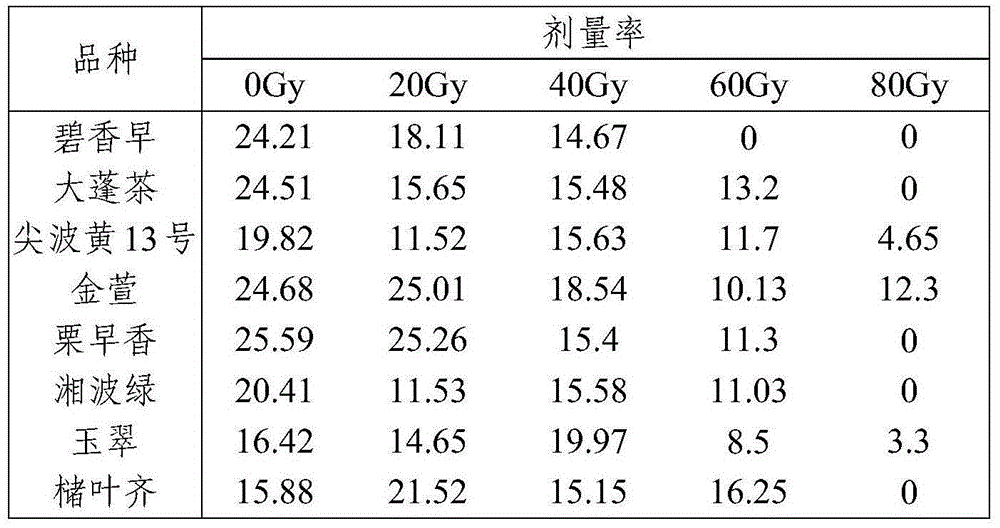Radiation breeding and selecting method for tea tree
A technology of radiation breeding and tea tree, applied in the fields of botanical equipment and methods, application, plant genetic improvement, etc., can solve the problems of self-incompatibility, difficult to produce breakthroughs, and long growth cycle.
- Summary
- Abstract
- Description
- Claims
- Application Information
AI Technical Summary
Problems solved by technology
Method used
Image
Examples
Embodiment 1
[0016] The determination of embodiment 1 radiation dose
[0017] In 2012, in Hunan, the fine varieties Bixiangzao, Dapengcha, Jianbohuang No. 13, Jinxuan, Lizaoxiang, Xiangbolu, Yucui, and Quanyeqi were selected as the female parents, and Yaubei and Quanjiao were granted as female parents. Mixed pollen of Ye Qi and Bi Xiangzao.
[0018] When harvesting hybrid seeds, it is required that the seeds have a clarity of ≥95%, a moisture content of 30-40%, and store at 4°C after sealing.
[0019] In the second year, the full-grained seeds will be selected in the Radiation Breeding Research Center of the Institute of Atomic Energy, Hunan Academy of Agricultural Sciences. 60 Co-γ-ray radiation, the radiation dose is 0, 20, 40, 60, 80, 100Gy, the irradiated seeds are planted in the field in the same year, the row spacing is 60cm, the plant spacing is 30cm, and the survival rate and seedling height of the seedlings are compared with the original female parent. The investigation of where...
Embodiment 2
[0025] Embodiment 2 selects and breeds good tea tree varieties with the tea tree radiation breeding breeding method of the present invention
[0026] The seedlings obtained after the radiation dose of 20-60Gy in Example 1 were selected, and the original female parent was used as a control to select beneficial mutant lines. The goals of trait selection are: tall plants, strong growth vigor (referring to thick stems, large leaves, and robust growth of the whole plant), strong tenderness of buds and leaves, and strong stress resistance (referring to disease resistance, drought resistance, and cold resistance), etc. The selection criterion is that one or more of the above traits are superior to the parent.
[0027] For 4 consecutive years, according to the above selection criteria, the beneficial mutant lines selected from the M1 generation (seedlings planted after radiation) were selected for excellent line selection, and a local main cultivar C. chinensis was added as a control....
PUM
 Login to View More
Login to View More Abstract
Description
Claims
Application Information
 Login to View More
Login to View More - Generate Ideas
- Intellectual Property
- Life Sciences
- Materials
- Tech Scout
- Unparalleled Data Quality
- Higher Quality Content
- 60% Fewer Hallucinations
Browse by: Latest US Patents, China's latest patents, Technical Efficacy Thesaurus, Application Domain, Technology Topic, Popular Technical Reports.
© 2025 PatSnap. All rights reserved.Legal|Privacy policy|Modern Slavery Act Transparency Statement|Sitemap|About US| Contact US: help@patsnap.com


